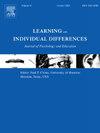二语学习研究中个体差异的效应量指南:二阶综合
IF 3.8
1区 心理学
Q1 PSYCHOLOGY, EDUCATIONAL
引用次数: 0
摘要
先前的研究已经确定,不同学科的效应量不同,需要特定学科的效应量基准来准确描述效应量。对第二语言学习个体差异的研究正在蓬勃发展,但缺乏效果大小指南。利用以往心理学研究的既定方法,二阶综合提出了二语学习个体差异相关系数的效应大小基准。对来自23项荟萃分析的1719个效应量的分析结果显示,第25百分位数r =±0.20,第50百分位数r =±0.35,第75百分位数r =±0.50。此外,使用个体差异分类,我们区分了认知差异、创造性差异、情感差异和人格差异。单因素方差分析显示不同类别之间存在显著差异。基于四分位数,为每个类别以及一般的第二语言个体差异研究制定了效应大小指南。教育相关性陈述当研究人员检查某些个体差异对语言学习的影响时,例如,如果某些人格特征可能有助于或阻碍某人学习第二语言(L2),他们可能会使用定量方法来探索这些影响。当使用定量方法时,例如相关性或回归,研究人员需要报告和解释他们所做的每个分析的效应大小。然而,解释效应量可能是复杂的,因为先前的研究已经确定,效应量往往会随着研究领域的不同而波动。在本研究中,我们探索了二语个体差异研究中常见的效应量,并制定了实用指南,供研究人员在未来解释其效应量时使用。我们还就研究人员为什么、何时以及如何解释该领域的效应大小给出了实用的建议。本文章由计算机程序翻译,如有差异,请以英文原文为准。
Effect size guidelines for individual differences in L2 learning studies: A second-order synthesis
Previous research has determined that effect sizes differ across disciplines, with discipline-specific effect size benchmarks needed to accurately describe effect sizes. Research into individual differences in second language (L2) learning is flourishing, however effect sizes guidelines are lacking. Using the established methodologies of previous studies in psychology, this second-order synthesis presents effect size benchmarks for correlation coefficients of individual differences in L2 learning. The analysis of 1719 effect sizes from 23 meta-analyses resulted in an overall 25th percentile of r = ±0.20, a 50th percentile of r = ±0.35, and a 75th percentile of r = ±0.50. In addition, using a taxonomy of individual differences categories, we distinguished between cognitive-, conative-, affective-, and personality differences. A one-way ANOVA showed significant differences between categories. Based on the quartiles, effect size guidelines were developed for each category as well as for L2 individual differences research in general.
Educational relevance statement
When researchers examine the effects that certain individual differences have on language learning, for example if certain personality traits may help or hinder someone in learning a second language (L2), they may use quantitative methods to explore these effects. When using quantitative methods, such as correlations or regressions, researchers need to report and interpret the effect sizes they find for each analysis that they do. However, interpreting effect sizes can be complex, as previous research has established that effect sizes tend to fluctuate depending on the research field. In this study, we explore effect sizes commonly found in L2 individual differences research and we develop practical guidelines that researchers may use to interpret their effect sizes in future. We also give practical advice as to why, when, and how researchers should interpret effect sizes in the field.
求助全文
通过发布文献求助,成功后即可免费获取论文全文。
去求助
来源期刊

Learning and Individual Differences
PSYCHOLOGY, EDUCATIONAL-
CiteScore
6.60
自引率
2.80%
发文量
86
期刊介绍:
Learning and Individual Differences is a research journal devoted to publishing articles of individual differences as they relate to learning within an educational context. The Journal focuses on original empirical studies of high theoretical and methodological rigor that that make a substantial scientific contribution. Learning and Individual Differences publishes original research. Manuscripts should be no longer than 7500 words of primary text (not including tables, figures, references).
 求助内容:
求助内容: 应助结果提醒方式:
应助结果提醒方式:


